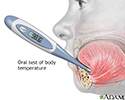Q fever
Query fever
Q fever is a bacterial infection. It can affect the lungs, liver, heart, or other parts of the body.
Causes
Q fever is found around the world. It is caused by the bacteria Coxiella burnetii . These bacteria can infect:
- Sheep
- Goats
- Cattle
- Dogs
- Cats
- Birds
- Rodents
-
Ticks
Ticks
Ticks are bugs that can attach to you as you brush past bushes, plants, and grass. Once on you, ticks often move to a warm, moist place on your body...
 ImageRead Article Now Book Mark Article
ImageRead Article Now Book Mark Article
Infected animals shed these bacteria in:
- Birth products
- Feces
- Milk
- Urine
Humans usually get Q fever by breathing in contaminated droplets released into the air by infected animals. Drinking raw milk has also caused infection in rare cases. People at highest risk for this infection are:
- Farmers
- Laboratory workers who work with Coxiella burnetii
- Sheep and dairy workers
- Veterinarians
You are at highest risk if you have heart valve problems or a weakened immune systems. Q fever during pregnancy can lead to:
- Spontaneous abortion
- Premature labor
- Fetal death
Symptoms
It usually takes about 20 days after exposure to the bacteria for symptoms to occur. Most cases are mild, yet some severe cases have been reported.
Common symptoms of early-stage (acute) Q fever may include:
- Dry cough
- Fever
- Headache
- Joint pain
- Muscle pain
Other symptoms may include:
- Abdominal pain
- Chest pain
- Rash
-
Yellow skin (
jaundice
)
Jaundice
Jaundice is a yellow color of the skin, mucus membranes, or eyes. The yellow coloring comes from bilirubin, a byproduct of old red blood cells. Jau...
 ImageRead Article Now Book Mark Article
ImageRead Article Now Book Mark Article
Symptoms of long-term (chronic) Q fever may include:
- Chills
- Fatigue
- Weight loss
- Night sweats
- Prolonged fever
- Shortness of breath
Sometimes the only symptom is prolonged fever that lasts for weeks or months. If you have the infection for more than 6 months, it is called chronic Q fever.
Exams and Tests
A health care provider will suspect Q fever if you have history of exposure to the Coxiella burnetii bacteria and develop:
- Inflammation of the inside lining of the heart and heart valves
- Flu-like symptoms
- Inflammation of the liver
- Pneumonia
Q fever is diagnosed with a blood antibody test.
Treatment
The main treatment for Q fever is antibiotics. For early-stage Q fever, doxycycline is the recommended.
If you have persistent or prolonged Q fever infection your provider may prescribe both doxycycline and hydroxychloroquine. You may need to take antibiotics for several months or years.
Outlook (Prognosis)
The outlook for people who get treated in the early stages of Q fever is generally good.
Chronic Q fever requires long-term treatment with antibiotics. Your provider should check you often to make sure the disease has not returned.
Possible Complications
Q fever may lead to these complications:
-
Bone infection
Bone infection
Osteomyelitis is a bone infection. It is mainly caused by bacteria or other germs.
 ImageRead Article Now Book Mark Article
ImageRead Article Now Book Mark Article - Brain infection
- Inflammation of the heart valves, heart lining, or heart muscle
- Liver infection
- Lung scarring
-
Inflammation of the thin tissue that surrounds the brain and spinal cord (
meningitis
)
Meningitis
Meningitis is an infection of the membranes covering the brain and spinal cord. This covering is called the meninges.
 ImageRead Article Now Book Mark Article
ImageRead Article Now Book Mark Article -
Pneumonia
Pneumonia
Pneumonia is a breathing (respiratory) condition in which there is an infection of the lung. This article covers community-acquired pneumonia (CAP). ...
 ImageRead Article Now Book Mark Article
ImageRead Article Now Book Mark Article
When to Contact a Medical Professional
Tell your provider if you have been exposed to Coxiella burnetii and have symptoms of Q fever. Although many different illnesses can cause similar symptoms, you may need to be evaluated for Q fever.
Prevention
People at risk (for example, farmers and veterinarians) should always:
- Carefully dispose of animal products that may be infected
- Disinfect any contaminated areas
- Thoroughly wash their hands
Pasteurizing milk can also help prevent Q fever.
Prompt treatment can prevent early Q fever from becoming chronic.
References
Marrie TJ, Raoult D. Coxiella burnetii (Q fever). In: Bennett JE, Dolin R, Blaser MJ, eds. Mandell, Douglas, and Bennett's Principles and Practice of Infectious Diseases, Updated Edition . 8th ed. Philadelphia, PA: Elsevier Saunders; 2015:chap 190.
Raoult D. Rickettsial infections. In: Goldman L, Schafer AI, eds. Goldman-Cecil Medicine . 25th ed. Philadelphia, PA: Elsevier Saunders; 2016:chap 327.
-
Temperature measurement - illustration
A thermometer is a useful aid used to measure body temperature. A thermometer is usually filled with mercury. Mercury in the tube rises when expanded by an increase in body temperature.
Temperature measurement
illustration
Review Date: 11/27/2016
Reviewed By: Arnold Lentnek, MD, Infectious Diseases Medical Practice of NY and Clinical Research Centers of CT. Review provided by VeriMed Healthcare Network. Also reviewed by David Zieve, MD, MHA, Medical Director, Brenda Conaway, Editorial Director, and the A.D.A.M. Editorial team.

